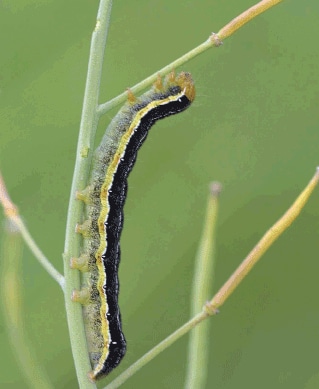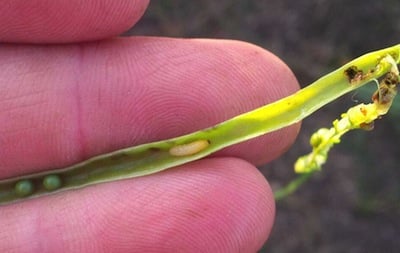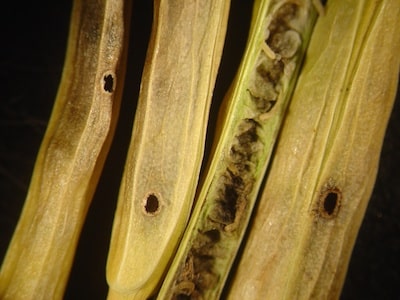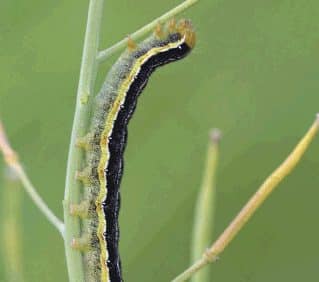
Bertha armyworms keep eating to within a few days of pupating. These 1.5” late-stage berthas eat much more than at smaller stages, doing a lot of damage in a week if numbers are at thresholds.
Swathing does not end the threat. The bertha armyworm feeding cycle tends to end before swathing starts, but not always. Swathing is not a guarantee that the threat is over if bertha armyworms are at thresholds and still actively feeding during swathing. They can continue to feed in the windrow.
Thresholds: If canola is $12 per bushel and control (insecticide and application) costs $12 per acre, the economic threshold is 17 larvae per square metre. At that number control only just pays for itself. Control costs applied at counts higher than 17 are more likely to provide some return on investment. Research has shown that 20 bertha armyworms per metre squared can reduce yield by 1.16 bushels per acre.
As long as you’re confident you’re below thresholds, don’t let a few big berthas feeding at the top of the crop change your decision.
When scouting for any insect, numbers can vary widely throughout a field. Sample at least 5 sites per field to get an average threshold. Numbers at field edges can sometimes overstate a problem. At the same time, if you don’t find anything at the first place you look doesn’t mean you don’t have a problem.
Dead or dying berthas indicate that some beneficial is at work, either a disease or insect. Beneficials can greatly reduce a threat, but if the numbers of actively feeding berthas are at or above thresholds, beneficials may not work fast enough to reduce the threat before economic losses occur. See the photo in the Issues of the Week article above.
The lygus threat: Some growers are still reporting lygus in canola. Bertha scouting should also include a look for other insects, including lygus. As pods mature and become leathery, lygus bugs are unable to pierce and feed and will move to less mature pods (ie. side branches). Examine the architecture of the plants, and quantify if these less mature areas are where the bulk of the yield is located. Consider also the growing conditions. Is there sufficient moisture to fill these later developing pods? If so, then it may be economical to spray late in the season (at least 7 days before swathing). Pay attention to pre-harvest intervals (see the article below) as many products are not approved for use that close to cutting, so this needs to be a primary consideration in choosing an insecticide at this stage. (Link: https://www.canolawatch.org/2013/08/14/what-is-the-economic-threshold-for-lygus-2/)
Cabbage seedpod weevil exit holes: Growers in southern Alberta and southwestern Saskatchewan where cabbage seedpod weevil counts are highest are encouraged to check pods for exit holes from weevil larvae. If less than 25% of pods have exit holes, a spray performed back during flowering could be considered a success. If less than 25% of pods have exit holes and the crop was not sprayed, it was probably the correct decision. If more than 25% have exit holes and the crop was not sprayed, it probably should have been.



